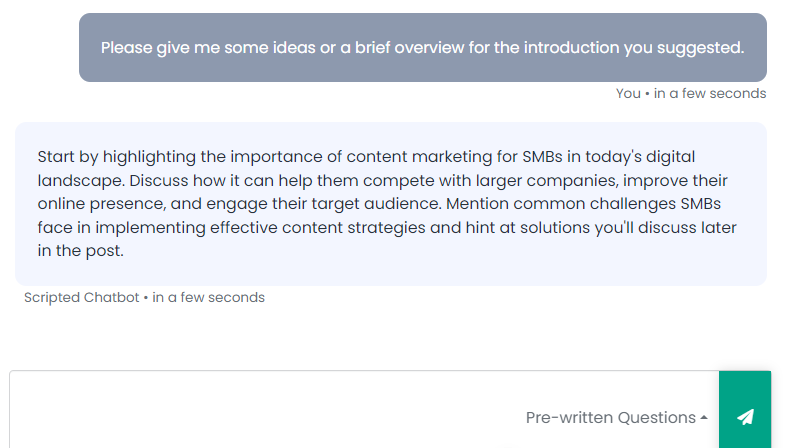- Blog Home
- Content
- Ciara Antolini
- Tips For Writing A Great Blog Post
Tips for Writing a Great Blog Post

A blog is an essential part of any website. It’s the centerpiece of content marketing, and it’s how businesses build brand awareness, authority, and recognition in their respective industries.
According to a study by the Content Marketing Institute, 73% of B2B (business-to-business) marketers and 70% of B2C (business-to-consumer) marketers included content marketing in their overall strategies. The research also shows that short blog posts comprise 83% of the content used by B2C marketers. Plus, the number of long-form blog posts and articles doubled.
A blog post that solves a reader’s problem or unmet need — a pain point — is often the first step in a buyer’s journey.
But what if you’re not already reaping the rewards? What if you’re just starting a blog? And how do you write a blog post that prospective customers will actually read?
One of the goals of content marketing is to create blog posts that generate leads, boost conversions, and increase your ROI (return on investment). Tactics and approaches differ among industries and niches, and what works for one company won’t work for another. But all successful blog posts — and how to write them — share specific characteristics.
Check out these tips for writing good blog posts that will make yours stand out from the competition.
1. Create a Great Headline

Your headline might be a clever play on words, but the best blog post headlines grab interest and announce your topic clearly. If the headline doesn't reflect potential readers' needs, they’ll skip over it in the SERPs (search engine results pages). If they click and the article doesn’t match the headline's promise, they’ll click back to find something better. And that affects your search engine rankings because it reduces dwell time and increases your bounce rate.
Some experts say you should create a headline after finishing your piece. But a clear headline helps you stay focused while writing. You can always tweak it later.
But How Do You Come Up With the Best Headlines for Blog Posts?
You brainstorm. Let’s say you’re writing an article about artificial intelligence (AI) in content marketing. “AI for Content Marketing” covers the topic, but it’s broad and bland. Brainstorming headlines can narrow down your topic.
Here's a cheat sheet for headlines:
- Ask a question: Is It Time to Use AI in Your Content Marketing?
- Start with a verb: Discover Ways to Use AI in Content Marketing
- Try a listicle: 10 Smart AI Tools for Creating Content
- Hit the Highlights: Increase Productivity and Lower Costs With AI
- List the Top 5, 10, or 100 [things]: The Top 20 AI Content Tools
- How to [do/make something]: How to Use AI in Your Content Marketing
- Be controversial: Why AI for Content Marketing Will Never Work Unless…
- Create urgency: Catch Up With AI Before Competitors Get Ahead
- Use numbers or stats: Increase ROI by 55% with AI for Content Marketing
- Teasers: You Won’t Believe How Generative AI Boosted My Sales
You could brainstorm all day, read up on how to create captivating headlines, and tweak your efforts until you’re satisfied. Or you could get a little help from Scripted's Headline Idea Generator.
The Headline Idea Generator is GPT-4 powered and saves so much time. Instead of spending an hour or two (or more) drafting headlines, pop in your keyword or topic and click “Get Headlines.” In a few seconds, you’ll get headlines like these:
- Boost Your Content Marketing Strategy With AI
- Harness the Power of AI in Content Marketing
- AI-Powered Content Marketing: A Game Changer
- Maximize Your Reach With AI-Driven Content Marketing
- Revolutionize Your Content Marketing Using AI
- Unlocking Success: Top 10 AI Techniques for Content Marketing
- Stay Ahead of the Curve: Embrace AI in Content Marketing
- Supercharge Your Content Marketing Efforts With AI
- The Future Is Here: AI and Content Marketing
- Mastering Content Marketing With Artificial Intelligence
You can generate more headlines until you get exactly what you need. Change the keywords, add more, or modify as needed. Any way you look at it, you'll save time.
For blog posts to convert to leads and sales, your target audience must read your blog posts, subscribe for updates, or sign up for your lead magnet or opt-in incentive. So make sure your blog post title grabs them.
AI won’t replace humans, but humans who use AI will replace those who don't. Stay ahead of the curve by embracing AI technology. Start your free 30-day trial and see how Scripted’s AI content tools can turn your blog posts into the top star in your content marketing strategy.
Recommended reading: Three Rules to Follow When Writing Good Headlines
2. Write What You Know: But What if You Don’t Know It?
You might have heard “Write what you know” countless times, but it’s good advice. You’re far more likely to write a passionate, energetic blog post that inspires readers when you write about something you know well and care about. That might be your business or industry, or if you’re a professional writer, it might be your specialty.
But what if you’re setting up a blog for the first time? What if you have a new business and want to develop a content marketing strategy? What if a significant new development you know nothing about takes place?
Write What Your Audience Needs to Know
Hardly anyone heard of ChatGPT before November 2022, when it was released. But it wasn’t long before everyone was writing about it. If you pop ChatGPT into Google, you'll get "About 1,120,000,000 results," and there’s sure to be more as time goes on.
You may be an excellent writer, but you can’t always write blog posts on what you know. Sometimes, you'll need to write on topics you’ve never heard of and target your audience effectively. So what do you do?
Research, of course. Hit the search engines. If the topic is in the news, browse the latest stories and opinions in well-respected publications, but don’t stop there. Search for studies and research from trusted, authoritative sources. Cross-reference information and statistics, too, and check if it’s fact or fiction, current or dated.
Take notes, and when you have enough information to understand your topic, you’re good to go.
Save Time Writing Blog Posts
You can save time by asking Scripted Copilot, Scripted’s Strategy Expert, for ideas and even blog post outlines.
Just add your keyword — let’s say it’s “AI tools for writing.” Next, select from pre-written prompts. For example:
Can you suggest some unique and trending topic ideas for a blog series in the [Industry/Niche]? Just replace “in the Industry/Niche” with “on AI tools for writing.”
You’ll get results like these:
- The Rise of AI in Professional Writing: A Game Changer?
- How AI Tools are Revolutionizing Content Creation
- AI and the Future of Copywriting: What to Expect
- Exploring GPT-4: The Next Generation of AI Writing Tools
- Balancing AI and Human Touch in Content Marketing
For an outline, use a different pre-written question.
Can you assist me in creating an effective outline for my blog post or article on [topic]?
Replace "topic" with your blog post subject or primary keyword. Let’s say it’s "content marketing for small to medium businesses (SMBs)."

The results are phenomenal. Ask Scripted Copilot for changes, modify the subject, or tweak as you like:
- Introduction: Importance of content marketing for SMBs.
- Benefits of Content Marketing: SEO, brand awareness, customer engagement.
- Strategies: Tailoring content to target audience, using storytelling, leveraging social media.
- Tools and Resources: Scripted's Keyword Research Tool, Blog Ideas, Headline Generator.
- Case Study: Successful SMB content marketing example.
- Challenges: Budget constraints, time management, maintaining quality.
- Conclusion: Emphasizing the role of human writers despite AI advancements.
It's a great start for writing a good blog post that gets results.
3. Create an Attention-Grabbing Intro for Blog Posts
Just like headlines, you might have heard advice to create your introduction after you write your blog post. The goal is to generate ideas while writing and include those topics in your introduction.
That can work for some. But if you want to stay on track, write your intro first. You can (and should) adjust and polish it later. But by being clear from the get-go about your topic and main points, you’ll save yourself a lot of time.
No need for perfection at first. Just be sure to include:
- The topic (use your primary keyword)
- The hook
- The problem or question
- The solutions or answers you’ll provide
Your introduction sets the scene for the rest of the article. As with your headline, it’s crucial to “hook” your reader’s attention immediately. Think of it as a label on a box or jar of food. You want to know what’s in it before buying, right?
How to Hook Readers in Blog Post Introductions
Food and most other products are packaged carefully with specific colors, designs, images, and fonts or text styles. It’s all intended for maximum psychological impact on prospective buyers.
Blog posts must also be "packaged,” but writers decorate with words.
So, how do you hook a reader in an introduction?
- Ask a provocative question
- Use a fascinating quote
- Mention a convincing statistic
- Be controversial
- Explain why the topic is important
- Reveal shocking facts
- Offer something relatable, like a personal anecdote
Keep in mind that readers leave the page within 15 seconds — they put the package back on the shelf — if they’re not hooked immediately. Grab their attention with an info-packed but concise intro.
Short on time or ideas? Get introduction ideas from Scripted Copilot.
If you like the introduction suggestion in an outline (as above), ask Scripted Copilot to develop it. You can use a prompt like this:
“Please give me some ideas or a brief overview for the introduction you suggested.”

You’ll want to spice it up and ensure it suits your purpose and target audience.
You can use a similar prompt even if you don't request an outline. Try “Could you please give me some ideas for a blog post introduction? My topic is How to Get Your House Ready for Sale."

Again, edit as needed or ask for something different.
Scripted Copilot, our GPT-4 Chatbot, is a fantastic time saver, and it's free! Give it a try with Scripted's Starter Plan. You’ll have access to Scripted Copilot plus the Landing Page Generator, Email Sequence Generator, free AI-driven Blog Ideas, and more.
Keep reading for two more essential tips for writing a good blog post!
4. Create Useful & Emotional Content

The reason a blog post should be useful is apparent: If it doesn't resonate with your target audience, why would they read it?
In some niches, “usefulness” might not be apparent. In a parenting blog, for example, a personal experience story might simply be enjoyable. In a fashion industry blog post, "Who Wore What" at the Met Gala is fun reading. In these cases, “usefulness” satisfies a need for entertainment or relaxation.
On the other hand, a parenting blog post that offers smart travel tips for families with young children is useful in a practical way. Similarly, an article on choosing suitable wardrobe colors for various hair colors or skin tones is helpful because it solves a problem: How to look good and feel confident.
Your Target Audience Defines Usefulness
Your target audience might cover a broad swath of readers and include various demographic variables, such as age, gender, education level, and household income. How do you write for all of them?
Write to solve problems: Readers of any parenting blog want to know how to raise kids, maintain a home, and juggle work or school. Many readers within that readership may buy or sell a house at some point. They need clear, easily understood information to make a complex process easier.
Focus on audience specifics: Young or new parents need advice that’s different from older parents with teenagers. But if both groups are in similar education and income groups, many interests may be similar. Consider breaking up a blog post into Part One and Part Two. First-time homebuyers need basic information, whereas experienced homeowners may want more depth.
Consider writing style and word choices: Highly educated, high-income parents may gravitate toward a somewhat formal writing style similar to publications they’re accustomed to reading — think Architectural Digest or The New York Times Style Magazine. Parents who are less educated with lower incomes might prefer a more casual writing style — think HGTV or Food Network.
How can a blog post be emotional?
Think about it: How do you feel when you (finally) learn how to fix a problem or find the info you were looking for? An emotional reaction to a blog post doesn’t necessarily mean readers gasp with delight or weep with joy.
When a blog post solves a problem or answers a question, readers might feel many emotions. They might feel relieved, satisfied, grateful, convinced, motivated, gratified, excited, and sure, even overjoyed, excited, or thrilled.
A positive emotional response can lead to trust, loyalty, and conversions. Plus, when readers feel good about a blog post, they’re likely to share it on social media — they become your brand advocate — which drives growth and search engine rankings.
How to Generate Positive Emotions in a Blog Post
Writing a good blog post that creates emotions isn't complicated, though it takes practice. Keep it simple.
Can you write in a friendly way? Do you believe your readers can accomplish what you’re trying to teach them or enjoy what you’re writing? Can you be genuine, honest, and authentic?
Sure you can. Here are a few tips for writing emotional content:
- Know your audience, their struggles, and their needs
- Imagine you are your target persona
- Take on the role of helper or mentor
- Use positive language
- Include inspirational quotes
- Make the reader/customer the main character
- Use empathy and show you understand
- Add a little humor
- Be relatable: Write from your heart
- Be credible: Express your own emotions
- Be vulnerable: Share a time when you had the same problem or felt the same way
- Use visual elements, including videos
Want to experience emotion in a blog post? Learn “How to Be Unforgettable.”
Recommended reading: Creating Emotional Resonance - What Role Does AI Play in Marketing?
5. Review, Edit, and Polish Your Blog Post

You’ve written your conclusion. Your blog post is finished. Bravo!
Hold on. If you haven’t read through it and made sure you’ve included everything it needs, you’re not quite done.
Set your draft aside, take a break, clear your mind, and return to it.
Review Your Blog Post Visually
Everything might make sense as you write because you know what you’re trying to say. But if you read objectively — try reading out loud or have your word processing app read it — you might find missing words and even sentences that make no sense (especially if you were up late).
Read closely. Ask yourself:
- Is every sentence clear and concise?
- Is anything repeated?
- Did I answer the question or solve the problem in the introduction?
- Have I provided examples to clarify complex topics?
- Have I included links for my sources and helpful information for readers?
- Are any statements condescending, insensitive, biased, or outdated?
- Did I check an editing checklist?
Watch out for the little mistakes. Even the most experienced professional writers mix up homophones like they’re/there/their, principal/principle, bear/bare, and its/it’s. It’s not that you don’t know better. It’s that your fingers are flying, and your brain can’t keep up. Expressing your ideas in an organized fashion is a separate task — it’s art. Editing is rules and regulations — science.
Readers notice misspelled words and typos. Errors destroy your credibility, and if there’s more than one or two, readers click back and look for something better. Check carefully.
Check punctuation closely
Periods or full stops and question marks are easy when sentences are simple. Commas get tricky. Many people say, “Place a comma where you pause,” but not all readers pause in the same places. Misplaced commas can lead to confusion, and that’s why we have rules.
Let's eat, Grandma!
Let's eat Grandma!
The best tip for writing a good blog post is to invest in a grammar and punctuation manual. Although many websites and blogs adhere to the AP Stylebook, it doesn’t cover everything. The most thorough publication that covers more than you’ll ever need is The Chicago Manual of Style. Another good choice is The Blue Book of Grammar and Punctuation.
And just when you think you’re finished (again), sorry! It’s time to let a machine take over.
Use an app like Grammarly or Hemingway to catch anything you missed. Even the most experienced writers use these tools — I certainly do.
Outwrite is another excellent tool; it highlights wordy phrases and confusing sentences and suggests alternatives. Plus, it checks spelling and punctuation. Caveat emptor: Some preferred punctuation is Australian English, even if you set it to U.S. English.
Use SEO Tools
SEO (search engine optimization) is a vast topic, but a list of tips for writing good blog posts wouldn't be complete without a mention.
If your blog post isn't optimized, your readers won't find it. Here’s a quick rundown of the basics. You’ll need to
- Write a high-quality blog post
- Research keywords
- Choose a primary keyword
- Use the primary keyword in your title tag, meta description, and slug (URL)
- Include your primary keyword in subheadings and sprinkle it throughout your blog post
Make your work easier with SEO tools. Some popular tools include
- Google Keyword Planner
- Semrush Keyword Research Toolkit
- MOZ Keyword Explorer
- Ahrefs Keyword Explorer
Surfer SEO is handy for keyword placement in blog posts, and Clearscope helps optimize your content in an easy-to-use format.
But why jump around various platforms when you can use Scripted’s Keyword Research Tool? Optimize your content strategy with near-instant keyword idea generation. You can use the Page Analyzer to evaluate old and new blog posts to bring them up to par.
Remember, SEO best practices fluctuate constantly, so be sure to keep up with the changes.
Leverage Scripted AI and Human Content for Good Blog Posts
Whether you’re a business owner, content marketer, or freelance writer, top-notch blog posts hold the key to conversion.
Content marketing doesn’t produce results as fast as well-designed paid ads can. It takes a little longer. But the advantage of content like blog posts is they have staying power. PPC (pay-per-click) ads and other forms of paid advertising stop producing leads when you stop paying for them. But blog posts are the Energizer Bunny™ of the blogosphere, and they keep going, and going, and going.
Need help for your blog posts or an entire series? Scripted is the only platform that empowers users to switch effortlessly between AI-generated content and content crafted by human experts.
Scripted eliminates the need for multiple platforms by providing a single, comprehensive solution that caters to both AI-generated and human-written content.
Experience a new level of content creation with Scripted — where AI meets human expertise, efficiency meets impact, and your content goals become reality.
Get started with a 30-day free trial or schedule a short video call with a Scripted Content Strategist.
Published by Ciara Antolini on Friday, November 10, 2023 in Content, Blogging, Blogs, Content Writing.


